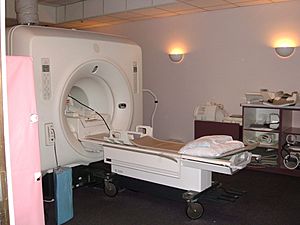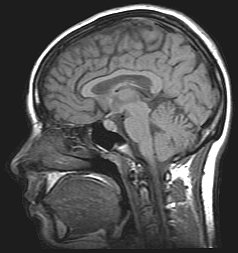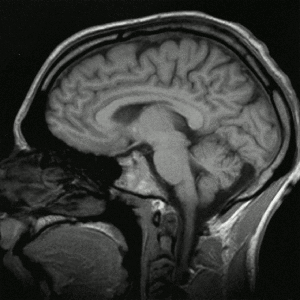Magnetic resonance imaging facts for kids
Magnetic resonance imaging (MRI) is a special way doctors look inside your body without needing surgery. It helps them see soft parts like your brain, muscles, and organs. MRI uses strong magnetic fields and radio waves to create detailed pictures.
Here's how it works: You lie down on a comfy bed that slides into a big machine. This machine has a powerful magnet. For a short time, the machine sends out radio waves. These waves make tiny parts inside your body's atoms send out special signals. The MRI machine listens for these signals. Then, a computer takes all the signal information and turns it into clear images of what's inside you. It's like taking a super detailed photo of your insides!
Contents
Why Doctors Use MRI Scans
MRI scans are very useful for finding problems that other tests, like X-rays, might miss. It's a painless test and a big plus is that it doesn't use harmful X-ray radiation.
Benefits of MRI
- Safe and Painless: MRI doesn't use radiation, which makes it safe for many people. The scan itself doesn't hurt at all.
- Detailed Pictures: It creates very clear images of soft tissues, which are hard to see with X-rays. This helps doctors find tiny problems.
- Finding Hidden Issues: MRI can help doctors find disorders in your body that might not be visible otherwise.
Things to Know About MRI
- Can Be Costly: MRI machines are very expensive, so the scans can cost a lot.
- Metal Objects: If you have metal inside your body, like certain hip or knee replacements, it might make the image a bit blurry. However, the scan can usually still be done. Some older medical devices, like certain pacemakers or Cochlear (ear) implants, might not be safe to use near an MRI machine. Doctors always check this carefully before a scan.
- Small Spaces: The MRI machine is a big tube, and some people might feel a bit nervous in small spaces. If this happens, doctors can sometimes give medicine to help you relax. There are also "open" MRI machines that are less enclosed.
- Special Dye: Sometimes, doctors might use a special liquid called a "contrast agent" to make the pictures even clearer. This liquid is usually given through a small needle.
What Body Parts MRI Scans Look At
MRI scans are amazing because they can look at almost any part of your body!
- Brain and Spine: Doctors use MRI to get clear pictures of your brain and spinal cord. This helps them understand how these important parts are working, especially after an injury.
- Bones and Joints: It's great for looking at your bones, joints, and the soft tissues around them, like ligaments and tendons.
- Heart and Blood Vessels: MRI can show the structure of your heart and major blood vessels, like the aorta. It can even help find blood clots.
- Other Organs: It can also look at organs inside your abdomen, like your liver, kidneys, and glands.
- Breasts: MRI scans can be used to study the breasts in detail.
By getting such clear images, MRI helps doctors make accurate diagnoses. Sometimes, knowing the results of an MRI scan can even help doctors decide if surgery is needed or how to plan it more carefully.
Related pages
Images for kids
-
A mobile MRI unit visiting Glebefields Health Centre, Tipton, England
-
MRI diffusion tensor imaging of white matter tracts
See also
 In Spanish: Imagen por resonancia magnética para niños
In Spanish: Imagen por resonancia magnética para niños











